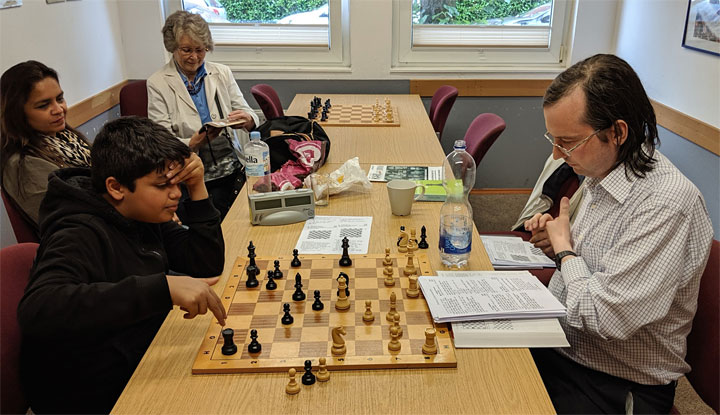.jpeg)

.jpeg)
Originally we planned to provide the solutions at the bottom of each puzzle page, around two weeks after publication. Not a good idea: it forces readers to keep returning to the original pages to check if the solutions have appeared. So today we bring you all the solutions on a separate page. You probably know full well that you can move pieces on our chess diagrams, and that the replayer will in fact allow you to start a chess engine (fan button) to assist you in your analysis. We wish you enjoyment with the solutions and look forward to your thoughts on these unusual puzzles.
 December 25th 2019: Pal Benko's last Merry Christmas Puzzle
December 25th 2019: Pal Benko's last Merry Christmas PuzzleIn July 2019, shortly before his passing, Pal Benko, who has always helped me with my Christmas Puzzles, sent me a first position for the 2019 season. He advised me to start with a famous problem, one that looks easy but needs some thinking outside the box.
The trick with the solution is: if it is White to move the previous move by Black must have been with one of the rooks or the king. If it was with the rook on a8 then Black cannot castle queenside and is mated with 1.♕g5 ♚f8 (or 1...♚d8 2.♕d5 ♚c8 3.♕xa8#) 2.♕xe7 Kg8 3.Qf7#. If on the other hand it was the rook on h8 that last moved then 1.♕d4 ♜g8 2.♕d7+ ♔f8 3.♕xe7# fulfils the task. But if we assume that it was the black king that last moved, then neither castle is possible, and White can mate in three with three different key moves: 1.♕c5, 1.♕g5 and 1.♕d4.
During a recent visit to Hamburg the 12-yearl-old chess prodigy Dev Shah, inspired by Pal Benko's beautiful three-mover, decided to try composing chess studies. We gave you two examples which Benko had evaluated: "Good initial effort by the boy!"

Young talent Dev Shah working with endgame expert GM Karsten Müller.

 December 26, 2019: What were the previous moves?
December 26, 2019: What were the previous moves?During the Christmas puzzle week we present you with puzzles that cannot be easily solved with a computer (the point of this endeavour). We give you tasks which require you to think all by yourself. On "boxing day" we had problems in which you were tasked with finding the previous move(s).

 December 27, 2019: Réti for beginners
December 27, 2019: Réti for beginnersOn a train trip I met two young boys, chess novices who had become bored playing each other. So I gave them a few simple (but famous) positions and taught them the Reti-manoeuvre. They were delighted. Here are the solutions to the studies I showed them:

 December 29, 2019: Missing pieces
December 29, 2019: Missing piecesThe following twin problem were by the famous English problemist Thomas Rayner Dawson. The two positions are clearly mirror images of each other, but for concrete reasons they do not have mirrored solutions. Could you tell why? Dawson was original if anything, and this is a puzzle he posed in 1927.

In each of these two positions the white queen has fallen off the board. Your task was : replace the queen and stalemate Black in one move. Solution: since the pawns are undisturbed the white queen must have, in both cases, fallen off from a square to the left of the king (how could she have got to the right?) So: in the first diagram the queen should be replaced on the square e1 and the move 1.f4 stalemates the black king. In the second diagram the queen is replaced on a1 and the move 1.a4 delivers stalemate. Were you able to figure this out?

Here are more missing pieces. In the first diagram (author unknown) both the kings have fallen off. Put them back on the board in such a way that White, on the move, can deliver immediate mate, i.e. mate in one move. Fairly simple: place the black king on h1 and the white king on f3. Then White can play 1.♔xf2#.
In the second problem by Dr Karl Fabel, Deutsche Schachblätter 1950, the black king has fallen off. You should place it somewhere on the board so that White can immediately mate in a single move. Solution: you may have been tempted to place the king on c1 and castle. But the black king can only have got to c1 if the white king had moved out of the way – and in that case White cannot castle. The correct solution is to place the black king on f3 and then castle. Perfectly legal.
Finally, we had two problems by Karl Fabel. In the first you had to construct, by entering legal moves for White and Black, who are naturally cooperating, a position in which Black has only the king on a4 and White has all his pieces on their original squares. The second is a study that is longer than expected. Here are the solutions:

Would you believe it — in the second simple-looking position White needs no less than 47 moves to win? Karl Fabel's problems are always ingenious, full of surprises.